Porous Silicon-Zinc Oxide Nanocomposites Prepared by Atomic Layer Deposition for Biophotonic Applications
Abstract
1. Introduction
2. Materials and Methods
3. Results and Discussion
3.1. Structural Properties of PSi/ZnO Nanocomposites
3.2. XPS Studies
3.3. Optical and Biosensing Properties
4. Conclusions
Author Contributions
Funding
Acknowledgments
Conflicts of Interest
References
- Myndrul, V.; Iatsunskyi, I. Nanosilicon-Based Composites for (Bio)sensing Applications: Current Status, Advantages, and Perspectives. Materials 2019, 12, 2880. [Google Scholar] [CrossRef]
- Iatsunskyi, I.; Smyntyna, V.; Pavlenko, M.; Kanevska, O.; Kirik, Y.; Myndrul, V. Ammonia detection using optical reflectance from porous silicon formed by metal-assisted chemical etching. In Proceedings of the Optics and Photonics for Counterterrorism, Crime Fighting and Defence IX; and Optical Materials and Biomaterials in Security and Defence Systems Technology X, Dresden, Germany, 23–24 September 2013; p. 8901. [Google Scholar]
- Tischler, M.A.; Collins, R.T.; Stathis, J.H.; Tsang, J.C. Luminescence degradation in porous silicon. Appl. Phys. Lett. 1992, 60, 639–641. [Google Scholar] [CrossRef]
- Iatsunskyi, I.; Jancelewicz, M.; Nowaczyk, G.; Kempiński, M.; Peplińska, B.; Jarek, M.; Załęski, K.; Jurga, S.; Smyntyna, V. Atomic layer deposition TiO2 coated porous silicon surface: Structural characterization and morphological features. Thin Solid Films 2015, 589, 303–308. [Google Scholar] [CrossRef]
- Brytavskyi, I.; Hušeková, K.; Myndrul, V.; Pavlenko, M.; Coy, E.; Zaleski, K.; Gregušová, D.; Yate, L.; Smyntyna, V.; Iatsunskyi, I. Effect of porous silicon substrate on structural, mechanical and optical properties of MOCVD and ALD ruthenium oxide nanolayers. Appl. Surf. Sci. 2019, 471, 686–693. [Google Scholar] [CrossRef]
- Silina, Y.E.; Koch, M.; Herbeck-Engel, P.; Iatsunskyi, I. Exploring the potential of high resolution inductively coupled plasma mass spectrometry towards non-destructive control and validation of electroless gold nanoparticles onto silicon nanowires hybrids. Anal. Methods 2019, 11, 3987–3995. [Google Scholar] [CrossRef]
- Pavlenko, M.; Siuzdak, K.; Coy, E.; Jancelewicz, M.; Jurga, S.; Iatsunskyi, I. Silicon/TiO2 core-shell nanopillar photoanodes for enhanced photoelectrochemical water oxidation. Int. J. Hydrogen Energy 2017, 42, 30076–30085. [Google Scholar] [CrossRef]
- Pavlenko, M.; Coy, E.L.; Jancelewicz, M.; Załȩski, K.; Smyntyna, V.; Jurga, S.; Iatsunskyi, I.; Zaleski, K.; Smyntyna, V.; Jurga, S.; et al. Enhancement of optical and mechanical properties of Si nanopillars by ALD TiO2 coating. RSC Adv. 2016, 6, 97070–97076. [Google Scholar] [CrossRef]
- Viter, R.; Savchuk, M.; Iatsunskyi, I.; Pietralik, Z.; Starodub, N.; Shpyrka, N.; Ramanaviciene, A.; Ramanavicius, A. Analytical, thermodynamical and kinetic characteristics of photoluminescence immunosensor for the determination of Ochratoxin A. Biosens. Bioelectron. 2018, 99, 237–243. [Google Scholar] [CrossRef]
- Tamashevski, A.; Harmaza, Y.; Viter, R.; Jevdokimovs, D.; Poplausks, R.; Slobozhanina, E.; Mikoliunaite, L.; Erts, D.; Ramanaviciene, A.; Ramanavicius, A. Zinc oxide nanorod based immunosensing platform for the determination of human leukemic cells. Talanta 2019, 200, 378–386. [Google Scholar] [CrossRef]
- Viter, R.; Savchuk, M.; Starodub, N.; Balevicius, Z.; Tumenas, S.; Ramanaviciene, A.; Jevdokimovs, D.; Erts, D.; Iatsunskyi, I.; Ramanavicius, A. Photoluminescence immunosensor based on bovine leukemia virus proteins immobilized on the ZnO nanorods. Sens. Actuators B Chem. 2019, 285, 601–606. [Google Scholar] [CrossRef]
- Rusli, N.I.; Tanikawa, M.; Mahmood, M.R.; Yasui, K.; Hashim, A.M. Growth of high-density zinc oxide nanorods on porous silicon by thermal evaporation. Materials 2012, 5, 2817–2832. [Google Scholar] [CrossRef]
- Hsu, H.-C.; Cheng, C.-S.; Chang, C.-C.; Yang, S.; Chang, C.-S.; Hsieh, W.-F. Orientation-enhanced growth and optical properties of ZnO nanowires grown on porous silicon substrates. Nanotechnology 2005, 16, 297–301. [Google Scholar] [CrossRef]
- Kanungo, J.; Saha, H.; Basu, S. Pd sensitized porous silicon hydrogen sensor—Influence of ZnO thin film. Sens. Actuators B Chem. 2010, 147, 128–136. [Google Scholar] [CrossRef]
- Yan, D.; Hu, M.; Li, S.; Liang, J.; Wu, Y.; Ma, S. Electrochemical deposition of ZnO nanostructures onto porous silicon and their enhanced gas sensing to NO2 at room temperature. Electrochim. Acta 2014, 115, 297–305. [Google Scholar] [CrossRef]
- Graniel, O.; Fedorenko, V.; Viter, R.; Iatsunskyi, I.; Nowaczyk, G.; Weber, M.; Załęski, K.; Jurga, S.; Smyntyna, V.; Miele, P.; et al. Optical properties of ZnO deposited by atomic layer deposition (ALD) on Si nanowires. Mater. Sci. Eng. B 2018, 236–237, 139–146. [Google Scholar] [CrossRef]
- Wang, Z.; Yu, R.; Wang, X.; Wu, W.; Wang, Z.L. Ultrafast Response p-Si/n-ZnO Heterojunction Ultraviolet Detector Based on Pyro-Phototronic Effect. Adv. Mater. 2016, 28, 6880–6886. [Google Scholar] [CrossRef]
- Huang, C.-Y.; Yang, Y.-J.; Chen, J.-Y.; Wang, C.-H.; Chen, Y.-F.; Hong, L.-S.; Liu, C.-S.; Wu, C.-Y. p-Si nanowires/SiO2/n-ZnO heterojunction photodiodes. Appl. Phys. Lett. 2010, 97, 013503. [Google Scholar] [CrossRef]
- Guo, Z.; Zhao, D.; Liu, Y.; Shen, D.; Zhang, J.; Li, B. Visible and ultraviolet light alternative photodetector based on ZnO nanowire/n-Si heterojunction. Appl. Phys. Lett. 2008, 93, 163501. [Google Scholar] [CrossRef]
- Choi, J.-H.; Das, S.N.; Moon, K.-J.; Kar, J.P.; Myoung, J.-M. Fabrication and characterization of p-Si nanowires/ZnO film heterojunction diode. Solid State Electron. 2010, 54, 1582–1585. [Google Scholar] [CrossRef]
- Zhang, H.; Jia, Z. Application of porous silicon microcavity to enhance photoluminescence of ZnO/PS nanocomposites in UV light emission. Optik (Stuttg) 2017, 130, 1183–1190. [Google Scholar] [CrossRef]
- Shabnam; Kant, C.R.; Arun, P. White-light emission from annealed ZnO:Si nanocomposite thin films. J. Lumin. 2012, 132, 1744–1749. [Google Scholar] [CrossRef]
- Shanmugam, N.R.; Muthukumar, S.; Prasad, S. A review on ZnO-based electrical biosensors for cardiac biomarker detection. Future Sci. OA 2017, 3, FSO196. [Google Scholar] [CrossRef] [PubMed]
- Tripathy, N.; Kim, D.-H. Metal oxide modified ZnO nanomaterials for biosensor applications. Nano Converg. 2018, 5, 27. [Google Scholar] [CrossRef] [PubMed]
- Napi, M.L.M.; Sultan, S.M.; Ismail, R.; How, K.W.; Ahmad, M.K. Electrochemical-Based Biosensors on Different Zinc Oxide Nanostructures: A Review. Materials 2019, 12, 2985. [Google Scholar] [CrossRef]
- Sampath, S.; Shestakova, M.; Maydannik, P.; Ivanova, T.; Homola, T.; Bryukvin, A.; Sillanpää, M.; Nagumothu, R.; Alagan, V. Photoelectrocatalytic activity of ZnO coated nano-porous silicon by atomic layer deposition. RSC Adv. 2016, 6, 25173–25178. [Google Scholar] [CrossRef]
- Sun, H.; Zhang, Q.-F.; Wu, J.-L. Electroluminescence from ZnO nanorods with an n-ZnO/p-Si heterojunction structure. Nanotechnology 2006, 17, 2271–2274. [Google Scholar] [CrossRef]
- Ye, J.D.; Gu, S.L.; Zhu, S.M.; Liu, W.; Liu, S.M.; Zhang, R.; Shi, Y.; Zheng, Y.D. Electroluminescent and transport mechanisms of n-ZnO/p-Si heterojunctions. Appl. Phys. Lett. 2006, 88, 182112. [Google Scholar] [CrossRef]
- Palanivelu, R.; Rubankumar, A. Synthesis and Spectroscopic Characterization of Hydroxyapatite by Sol-Gel Method. Int. J. ChemTech Res. 2013, 5, 2965–2969. [Google Scholar]
- Singh, R.G.; Singh, F.; Agarwal, V.; Mehra, R.M. Photoluminescence studies of ZnO/porous silicon nanocomposites. J. Phys. D Appl. Phys. 2007, 40, 3090–3093. [Google Scholar] [CrossRef]
- Ambrosio, R.; Galindo, F.; Morales–Morales, F.; Moreno, M.; Torres, A.; Vásquez-A, M.A.; Pérez García, S.A.; Morales–Sánchez, A. Effect of the thermal annealing on the structural, morphological and photoluminescent properties of ZnO/Si multilayers. Opt. Mater. 2019, 96, 109339. [Google Scholar] [CrossRef]
- Olenych, I.B.; Monastyrskii, L.S.; Luchechko, A.P. Photoluminescence of Porous Silicon–Zinc Oxide Hybrid structures. J. Appl. Spectrosc. 2017, 84, 66–70. [Google Scholar] [CrossRef]
- Sun, L.; He, H.; Liu, C.; Lu, Y.; Ye, Z. Controllable growth and optical properties of ZnO nanostructures on Si nanowire arrays. CrystEngComm 2011, 13, 2439–2444. [Google Scholar] [CrossRef]
- Dalvand, R.; Mahmud, S.; Alimanesh, M.; Vakili, A.H. Optical and structural properties of well-aligned ZnO nanoneedle arrays grown on porous silicon substrates by electric field-assisted aqueous solution method. Ceram. Int. 2017, 43, 1488–1494. [Google Scholar] [CrossRef]
- Singh, R.G.; Singh, F.; Kanjilal, D.; Agarwal, V.; Mehra, R.M. White light emission from chemically synthesized ZnO–porous silicon nanocomposite. J. Phys. D Appl. Phys. 2009, 42, 062002. [Google Scholar] [CrossRef]
- Graniel, O.; Iatsunskyi, I.; Coy, E.; Humbert, C.; Barbillon, G.; Michel, T.; Maurin, D.; Balme, S.; Miele, P.; Bechelany, M. Au-covered hollow urchin-like ZnO nanostructures for surface-enhanced Raman scattering sensing. J. Mater. Chem. C 2019, 7, 15066–15073. [Google Scholar] [CrossRef]
- Iatsunskyi, I.; Baitimirova, M.; Coy, E.; Yate, L.; Viter, R.; Ramanavicius, A.; Jurga, S.; Bechelany, M.; Erts, D. Influence of ZnO/graphene nanolaminate periodicity on their structural and mechanical properties. J. Mater. Sci. Technol. 2018, 34, 1487–1493. [Google Scholar] [CrossRef]
- Titov, V.V.; Lisachenko, A.A.; Akopyan, I.K.; Labzowskaya, M.E.; Novikov, B.V. On the nature of the effect of adsorbed oxygen on the excitonic photoluminescence of ZnO. J. Lumin. 2018, 195, 153–158. [Google Scholar] [CrossRef]
- Iatsunskyi, I.; Kempiński, M.; Jancelewicz, M.; Załęski, K.; Jurga, S.; Smyntyna, V. Structural and XPS characterization of ALD Al2O3 coated porous silicon. Vacuum 2015, 113, 52–58. [Google Scholar] [CrossRef]
- Dellis, S.; Pliatsikas, N.; Kalfagiannis, N.; Lidor-Shalev, O.; Papaderakis, A.; Vourlias, G.; Sotiropoulos, S.; Koutsogeorgis, D.C.; Mastai, Y.; Patsalas, P. Broadband luminescence in defect-engineered electrochemically produced porous Si/ZnO nanostructures. Sci. Rep. 2018, 8, 6988. [Google Scholar] [CrossRef]
- Gallach-Pérez, D.; Muñoz-Noval, A.; García-Pelayo, L.; Manso-Silván, M.; Torres-Costa, V. Tunnel conduction regimes, white-light emission and band diagram of porous silicon–zinc oxide nanocomposites. J. Lumin. 2017, 191, 107–111. [Google Scholar] [CrossRef]
- Prabakaran, R.; Peres, M.; Monteiro, T.; Fortunato, E.; Martins, R.; Ferreira, I. The effects of ZnO coating on the photoluminescence properties of porous silicon for the advanced optoelectronic devices. J. Non-Cryst. Solids 2008, 354, 2181–2185. [Google Scholar] [CrossRef]
- Kayahan, E. White light luminescence from annealed thin ZnO deposited porous silicon. J. Lumin. 2010, 130, 1295–1299. [Google Scholar] [CrossRef]
- Algün, G.; Akçay, N. The role of etching current density and porous structure on enhanced photovoltaic performance of ZnO/PS heterojunction solar cells. Appl. Phys. A 2019, 125, 568. [Google Scholar] [CrossRef]
- Aydemir, G.; Utlu, G.; Çetinel, A. Growth and characterization of ZnO nanostructures on porous silicon substrates: Effect of solution temperature. Chem. Phys. Lett. 2019, 737, 136827. [Google Scholar] [CrossRef]
- Speranza, G.; Canteri, R. RxpsG a new open project for Photoelectron and Electron Spectroscopy data processing. SoftwareX 2019, 10, 100282. [Google Scholar] [CrossRef]
- Han, H.; Huang, Z.; Lee, W. Metal-assisted chemical etching of silicon and nanotechnology applications. Nano Today 2014, 9, 271–304. [Google Scholar] [CrossRef]
- Iatsunskyi, I.; Pavlenko, M.; Viter, R.; Jancelewicz, M.; Nowaczyk, G.; Baleviciute, I.; Załęski, K.; Jurga, S.; Ramanavicius, A.; Smyntyna, V. Tailoring the Structural, Optical, and Photoluminescence Properties of Porous Silicon/TiO2 Nanostructures. J. Phys. Chem. C 2015, 119, 7164–7171. [Google Scholar] [CrossRef]
- Iatsunskyi, I.; Kempiński, M.; Nowaczyk, G.; Jancelewicz, M.; Pavlenko, M.; Załęski, K.; Jurga, S. Structural and XPS studies of PSi/TiO2 nanocomposites prepared by ALD and Ag-assisted chemical etching. Appl. Surf. Sci. 2015, 347, 777–783. [Google Scholar] [CrossRef]
- Iatsunskyi, I.; Vasylenko, A.; Viter, R.; Kempiński, M.; Nowaczyk, G.; Jurga, S.; Bechelany, M. Tailoring of the electronic properties of ZnO-polyacrylonitrile nanofibers: Experiment and theory. Appl. Surf. Sci. 2017, 411, 494–501. [Google Scholar] [CrossRef]
- Bisi, O.; Ossicini, S.; Pavesi, L. Porous silicon: A quantum sponge structure for silicon based optoelectronics. Surf. Sci. Rep. 2000, 38, 1–126. [Google Scholar] [CrossRef]
- Iatsunskyi, I.; Nowaczyk, G.; Jurga, S.; Fedorenko, V.; Pavlenko, M.; Smyntyna, V. One and two-phonon Raman scattering from nanostructured silicon. Optik 2015, 126, 1650–1655. [Google Scholar] [CrossRef]
- Marin, O.; Grinblat, G.; María, A.; Tirado, M.; Koropecki, R.R.; Comedi, D. Superlattices and Microstructures On the origin of white photoluminescence from ZnO nanocones/porous silicon heterostructures at room temperature. Superlattices Microstruct. 2015, 79, 29–37. [Google Scholar] [CrossRef]
- Ma, Q.L.; Zhai, B.G.; Huang, Y.M. Sol-gel derived ZnO/porous silicon composites for tunable photoluminescence. J. Sol-Gel Sci. Technol. 2012, 64, 110–116. [Google Scholar] [CrossRef]
- Iatsunskyi, I.; Myndrul, V.; Smyntyna, V.; Viter, R.; Melnyk, Y.; Pavlova, K. Porous silicon photoluminescence biosensor for rapid and sensitive detection of toxins. Org. Sens. Bioelectron. X 2017, 10364, 28. [Google Scholar] [CrossRef]
- Myndrul, V.; Viter, R.; Savchuk, M.; Koval, M.; Starodub, N.; Silamiķelis, V.; Smyntyna, V.; Ramanavicius, A.; Iatsunskyi, I. Gold coated porous silicon nanocomposite as a substrate for photoluminescence-based immunosensor suitable for the determination of Aflatoxin B1. Talanta 2017, 175, 297–304. [Google Scholar] [CrossRef]
- Viter, R.; Iatsunskyi, I. Metal Oxide Nanostructures in Sensing. In Nanomaterials Design for Sensing Applications; Zenkina, O.V., Ed.; Elsevier: Amsterdam, The Netherlands, 2019; pp. 41–91. ISBN 978-0-12-814505-0. [Google Scholar]
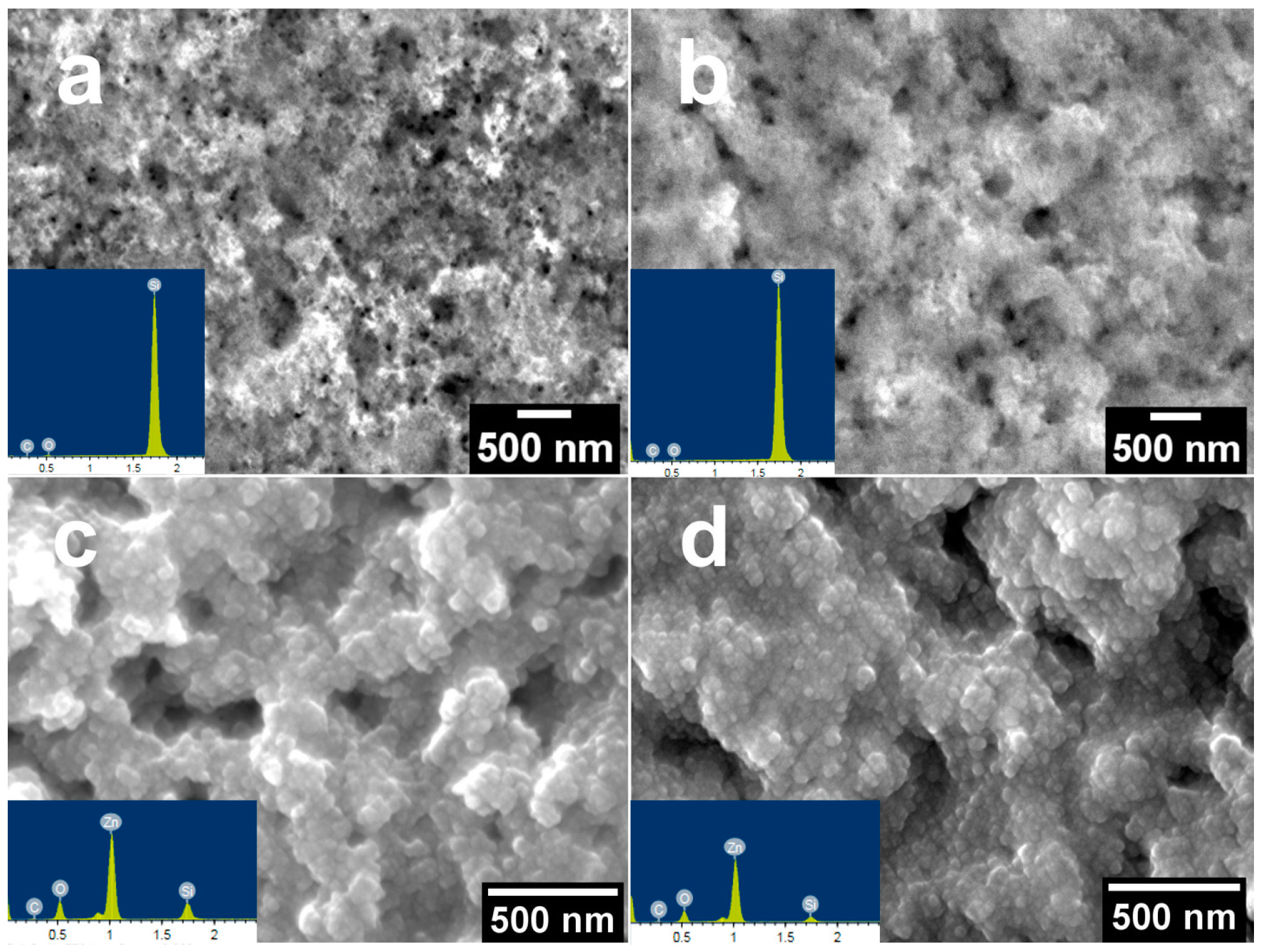
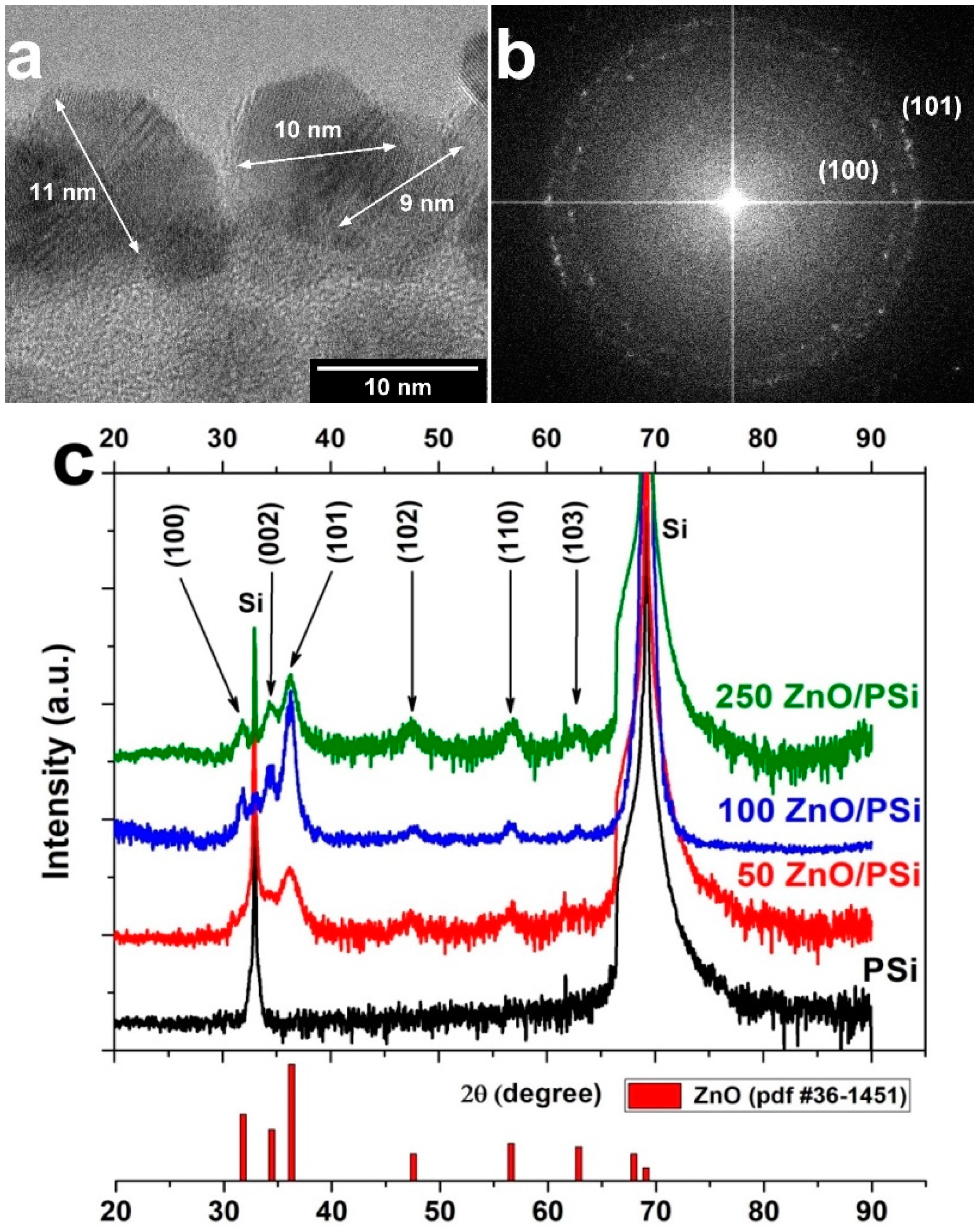
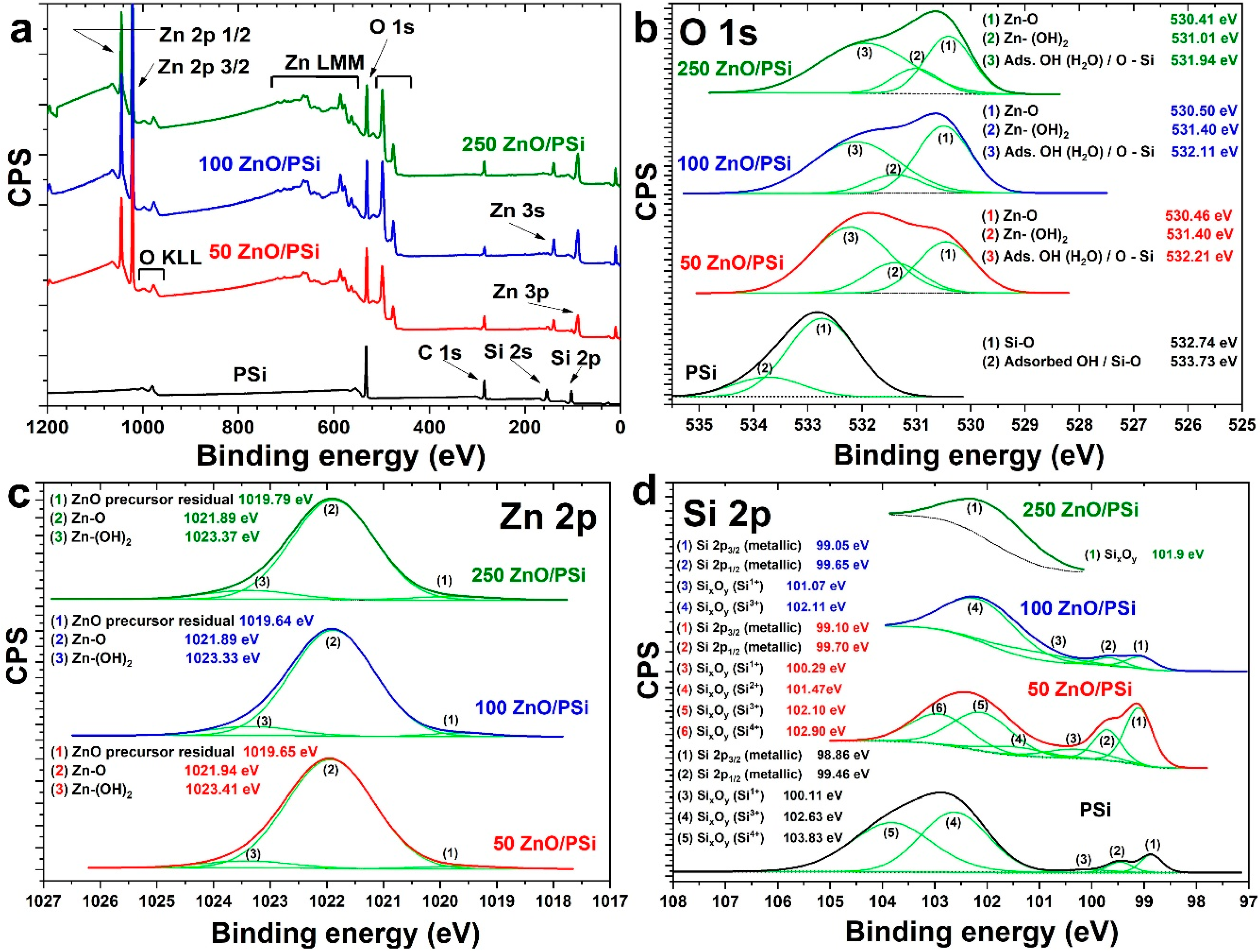
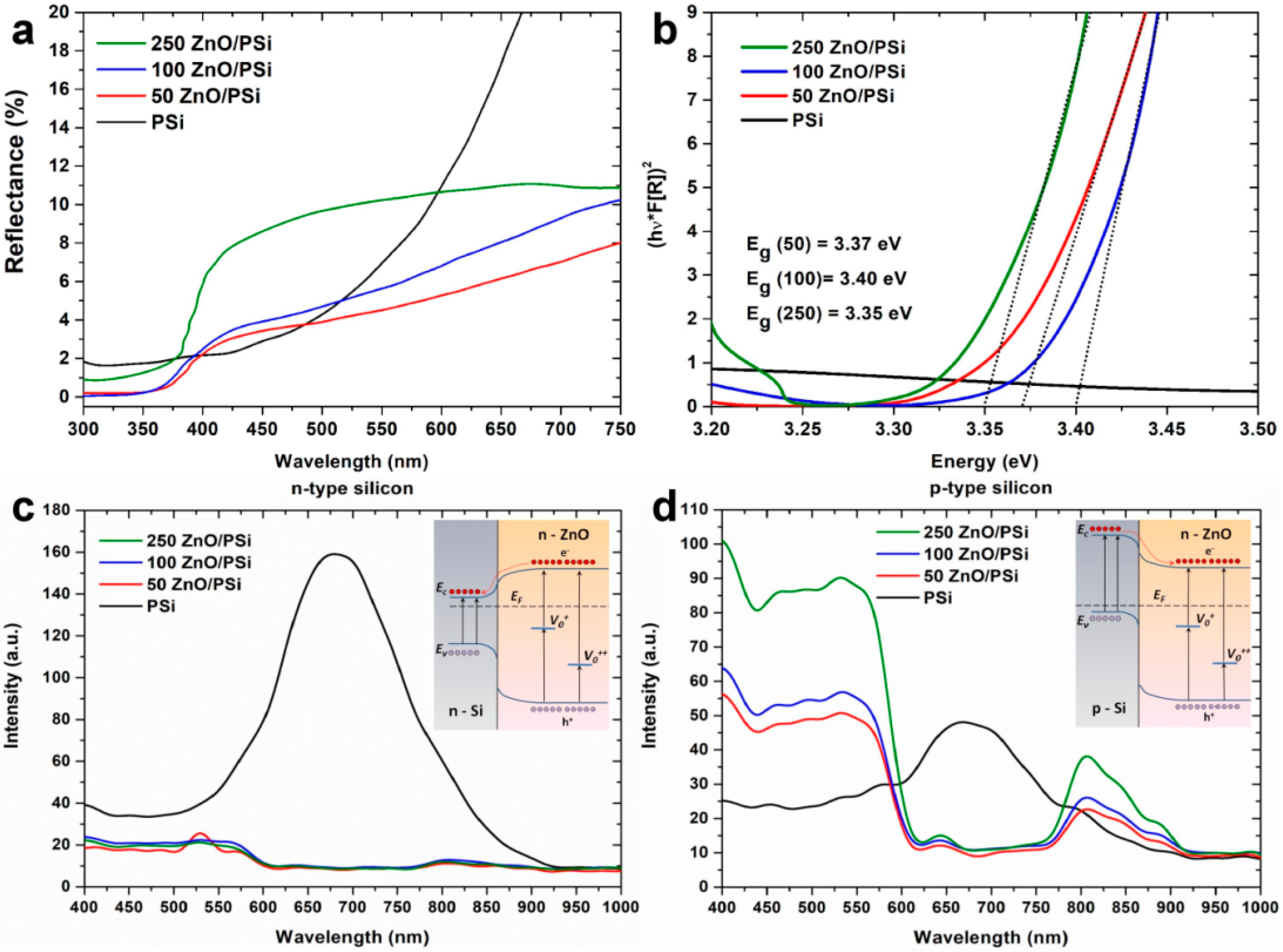
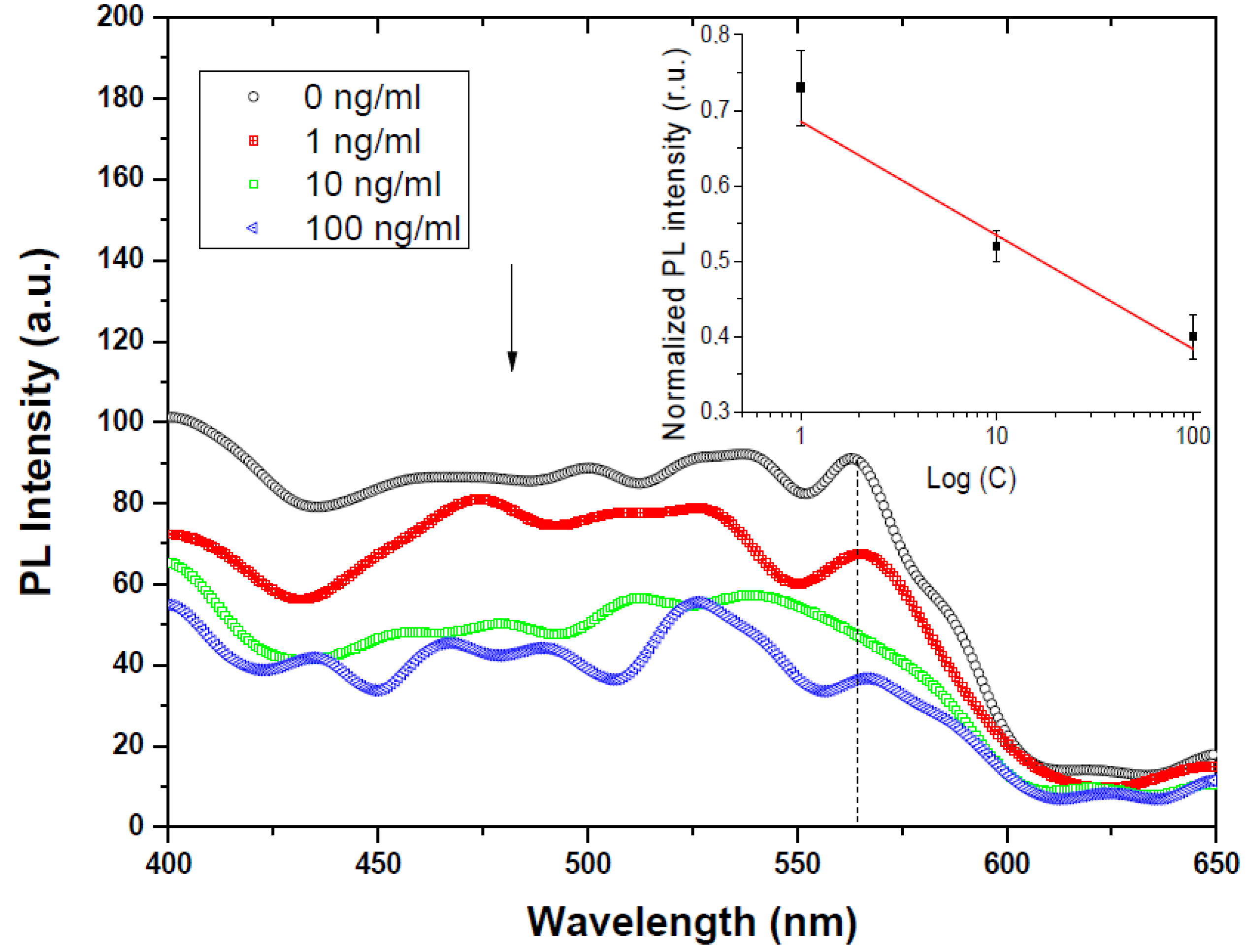
| Sample | Zn (in Zn-O), at. % | O (in Zn-O), at % | O/Zn |
|---|---|---|---|
| 250 PSi/ZnO | 17.85 | 18.21 | 1.02 |
| 100 PSi/ZnO | 20.54 | 20.38 | 0.99 |
| 50 PSi/ZnO | 15.48 | 14.00 | 0.90 |
© 2020 by the authors. Licensee MDPI, Basel, Switzerland. This article is an open access article distributed under the terms and conditions of the Creative Commons Attribution (CC BY) license (http://creativecommons.org/licenses/by/4.0/).
Share and Cite
Pavlenko, M.; Myndrul, V.; Gottardi, G.; Coy, E.; Jancelewicz, M.; Iatsunskyi, I. Porous Silicon-Zinc Oxide Nanocomposites Prepared by Atomic Layer Deposition for Biophotonic Applications. Materials 2020, 13, 1987. https://doi.org/10.3390/ma13081987
Pavlenko M, Myndrul V, Gottardi G, Coy E, Jancelewicz M, Iatsunskyi I. Porous Silicon-Zinc Oxide Nanocomposites Prepared by Atomic Layer Deposition for Biophotonic Applications. Materials. 2020; 13(8):1987. https://doi.org/10.3390/ma13081987
Chicago/Turabian StylePavlenko, Mykola, Valerii Myndrul, Gloria Gottardi, Emerson Coy, Mariusz Jancelewicz, and Igor Iatsunskyi. 2020. "Porous Silicon-Zinc Oxide Nanocomposites Prepared by Atomic Layer Deposition for Biophotonic Applications" Materials 13, no. 8: 1987. https://doi.org/10.3390/ma13081987
APA StylePavlenko, M., Myndrul, V., Gottardi, G., Coy, E., Jancelewicz, M., & Iatsunskyi, I. (2020). Porous Silicon-Zinc Oxide Nanocomposites Prepared by Atomic Layer Deposition for Biophotonic Applications. Materials, 13(8), 1987. https://doi.org/10.3390/ma13081987








